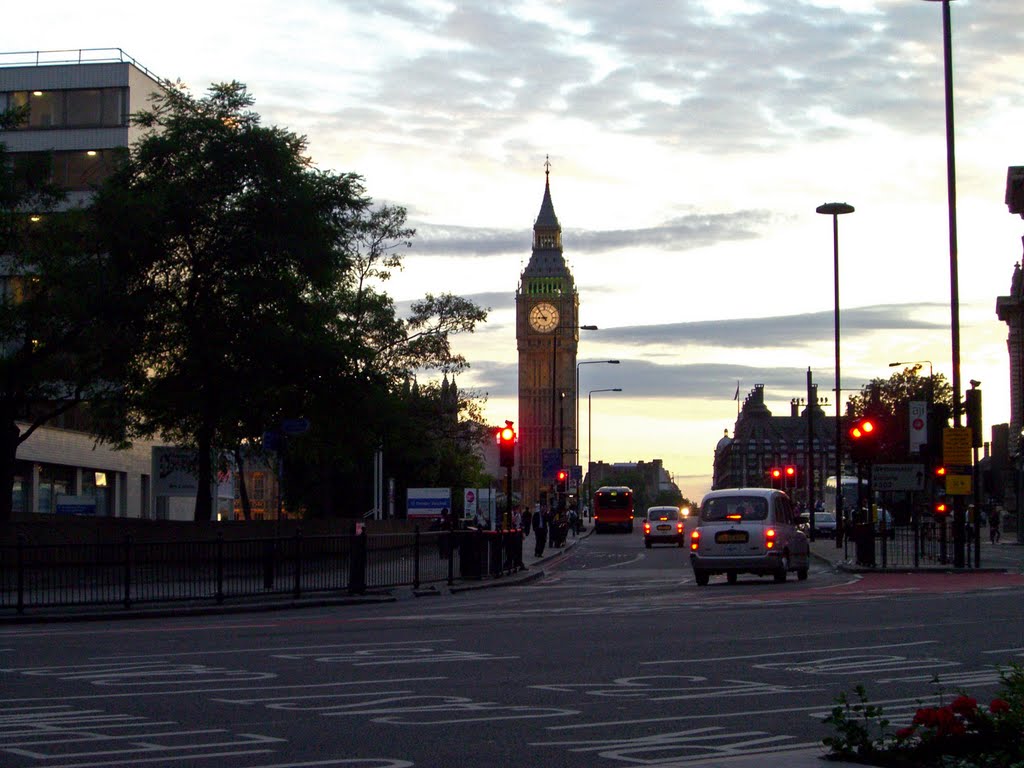
The Palace of Westminster in London is commonly known as the Houses of Parliament. Located on the left bank of the River Thames, it features three main towers. At the north end of the Palace rises the most famous of the towers, Elizabeth Tower, which was formerly known as St. Stephen’s Tower. The slick and graceful tower is 316 feet (96 m) tall and is complete with a 200feet (61m) high brick shaft crowned with a cast iron framed spire. It is slightly shorter than Victoria Tower at the southwest corner, but much slimmer. Popularly known as ‘Big Ben’, the tower is one of the most iconic landmarks of London. Actually, Big Ben is the nickname given to the five giant bells of the clock inside this famous clock tower and the name is extended to mean both the clock and the clock tower. Today, the whole tower, including the huge clock is commonly referred to as Big Ben. The clock faces are 180 feet (55 m) above ground level and the tower looks spectacular at night when the four faces of the clock are illuminated.


The St. Stephen’s Tower was renamed Elizabeth Tower in 2012, on the occasion of the Diamond Jubilee celebration of Queen Elizabeth and the tower celebrated its 150 th anniversary in May 2009 and it has a long and fascinating history. The Palace of Westminster was constructed on the site of a royal palace, said to have existed under the Danish king of England Canute. A fire in 1834 destroyed almost the whole palace, however the disastrous event eventually led to the building of one of London's most prominent attractions and a world famous landmark of the city.
After numerous hostilities, disputes and lawsuits, the construction of the clock tower began in 1843, under Charles Barry as the chief architect and it took 13 years to complete the project. It is 316 feet high and the climb from ground level to the belfry is 334 steps. Its base is square, measuring 39 feet (12 m) on each side. The tower leans slightly to the northwest by 8.6 inches (220mm). Within the tower there are three shafts. The clock shaft houses the weights which hang below the clock room. The second shaft acts as a ventilation chimney, while the third contains the staircase with 340 steps. There are several rooms in the lower part, which surprisingly includes a prison cell.

The responsibility to build the clock mechanism was entrusted to Edward John Dent in 1852 and after his sudden death, his nephew, Frederick Dent was hastily drafted in to complete the work. The clock mechanism was completed in 1854 but could not be installed as the tower was incomplete. The clock and bell were installed together in 1859. At that time the huge clock was undoubtedly the world's largest clock and is still considered as the largest mechanical clock in world.
The first casting of the giant bell had failed and the second casting was pulled to the tower by a wagon team of 16 horses, a feat that took 18 hours. The bell first chimed in July 1859, but unfortunately, within a short time of its installation, in September, it too developed a crack under the hammer and was kept out of service until its repair in 1862. During World War I, the bell of the Big Ben was kept silent to avoid attraction of the enemy aircraft and during WW II, it was not illuminated for the same reason.
The clock and the dials were designed by Augustus Pugin. The dials are set in an iron frame 23 feet (7.0 m) in diameter, supporting 312 pieces of detachable opal glass, which gives it a look like a stained glass window. The detachable glass pieces may be removed for inspection of the hands. Outside the circling area of the clock-hands, the surrounding square area of the face of the dials is gilded. The clock is known for its reliability and it has rarely failed.


Probably, the hour bell was named after the First Commissioner of the project, Benjamin Hall, while some other sources claim that, it was named after Benjamin Caunt, a British heavyweight boxing champion. In any event, the main hour bell, officially known as the ‘Great Bell’ but better known as ‘Big Ben’ inside the clock tower, weighs more than 13 tons. In addition to the Great Bell, there are four quarter bells, which play the ‘West Minster Quarters’ on the quarter hours. Beneath the clock-room, a meticulously crafted wind-proof box contains the pendulum of the clock. It is 13 feet (4.0 m) long, weighs 300 kg, suspended on a strip of spring steel 1/64 inch in thickness, and beats every 2 seconds. A small stack of old penny coins is kept on the top of the pendulum . Adding or removing a penny changes the clock speed by 0.4 seconds per day. The clock needs to be wound up three times a week and it takes about 1:5 hours to wind it up. The hour hand of the clock is 9 feet (2.7m) long and the minute hand measures 14 feet (4.25m) long. The dial of the clock is somewhat peculiar. To indicate ‘4’, most of the Roman numeral clock dials show “IIII”, while the Great Clock faces depict '4' as 'IV'.


On 21 August 2017, a four-year schedule of renovation works began on the tower, which is to include the addition of a lift and to re-glaze and repaint the dials of the clock.
The Big Ben Clock Tower, a World Heritage Site since 1987, is one of the most prominent cultural symbols of the United Kingdom and parliamentary democracy. A popular survey of 2.000 people in 2008 found that the tower was the most popular landmark in the United Kingdom.